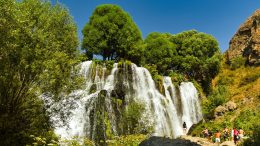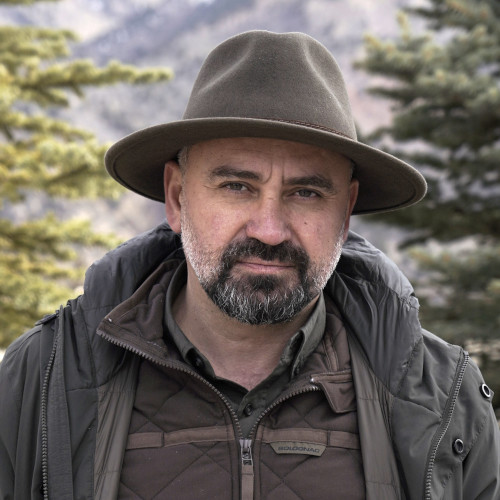Some people know Armenia — the small, landlocked country in the South Caucasus that I call home — for its ancient monasteries or its growing agricultural and wine tourism. Others recognize it for its geopolitical challenges in a turbulent part of the world. But the most important story may be its emerging commitment to conservation: Armenia will host the 17th Conference of the Parties (COP17) to the United Nations Convention on Biological Diversity in 2026.
While far from a model of environmental stewardship, Armenia’s journey to becoming host of one of the most significant gatherings of the many COPs offers timely lessons on the delicate dance between politics, development, and nature.
Lesson One: Biodiversity Is Not Enough Without Protection and Clear Targets
Packed into a territory smaller than Maryland, Armenia is one of the most biodiverse countries per square mile on Earth. With ecosystems ranging from alpine meadows to semi-desert, it’s home to more than 3,800 plant species and over 17,000 animal species, including the endangered Caucasian leopard and Armenian mouflon.
View this post on Instagram
Its extraordinary biological wealth stems from rapid elevation changes and unique ecological zones, making it a vital part of the Caucasus and Irano-Anatolian Biodiversity Hotspots — two of only 36 such hotspots worldwide recognized by Conservation International.
But biodiversity alone is not enough. Armenia’s ecological richness sits uneasily alongside a legacy of weak enforcement, an expanding extractive industry, and (until recently) underfunded environmental institutions.
The country is making progress: It has so far protected about 13% of its territory, although this will need to accelerate to meet the global “30×30” pledge (which aims to safeguard 30% of the world’s land and seas by 2030). Armenia is also yet to submit its National Biodiversity Strategy and Action Plan — a priority for 2025.
Lesson Two: Growth and Sustainability Must Be Reconciled Early
Perhaps nowhere is Armenia’s tension between development and conservation more visible than in the saga of the Amulsar gold mine.
Pitched as a boon to economic development, the mine has faced years of legal battles and mass protests. Opponents warn of irreversible environmental damage, while supporters cite jobs and foreign investment. The government has often wavered, caught between these competing pressures.
The takeaway here is not to demonize all development, but to recognize that sustainable growth requires clear frameworks, public consultations, and environmental assessments from the outset to gain public trust. Furthermore, government needs to develop a framework on how it will assess a project’s environmental impact and whether the risks outweigh legitimate corporate and economic interests in the long run. This is especially important in nations where economic needs are urgent.
Lesson Three: Legacy Systems Must Evolve
Armenia inherited a Soviet conservation infrastructure built on strict, top-down controls with minimal community input. After independence economic collapse and political instability eroded environmental enforcement, leaving many reserves vulnerable to neglect. While Armenia has enacted new environmental laws, implementation remains patchy.
The country’s evolution reflects a broader challenge: transforming legacy systems into adaptive ones. Environmental progress depends not just on new rules, but on institutions that can implement them and civil society actors who hold them accountable (here, the National Biodiversity Strategy and Action Plans are critical in meeting targets).
Lesson Four: Local Solutions Often Work Better Than Central Ones
In recent years Armenia has begun to experiment with a different model — one that decentralizes conservation and empowers local communities. Organizations like mine, the Foundation for the Preservation of Wildlife and Cultural Assets, work directly with rangers and local communities, bypassing bureaucracy to support grassroots stewardship.
By creating a privately protected area we are contributing to Other Effective area-based Conservation Measures (OECMs), and we argue that these areas should be included in the government’s 30×30 target.
By managing the Caucasus Wildlife Refuge, the Foundation delivers swift, community-driven conservation in key biodiversity hotspots, which contributes to an additional 1% of the country’s protected land (115 square miles or 30,000 hectares).
This shift toward bottom-up conservation is not just pragmatic in Armenia’s context of weak state capacity — it’s increasingly relevant worldwide. In places where top-down governance struggles, durable environmental solutions often start with the people who live closest to the land and best placed to protect them. This, of course, is different from the U.S. context, with the local control idea is sometimes used to oppose eco-friendly ideas.
Lesson Five: Nature Cannot Be Separated From Conflict
Geopolitical instability adds another layer of complexity. Armenia’s borders remain tense after recent conflicts with neighboring Azerbaijan over the Nagorno-Karabakh region.
In some cases militarized zones have accidentally become wildlife refuges. But war also devastates ecosystems, displaces conservation staff, and severs the cross-border collaboration that biodiversity depends on.
This is a reminder that environmental strategy must factor in human conflict — not as a footnote, but as a central challenge. In fragile regions peacebuilding and conservation are deeply intertwined.
Lesson Six: Reframing Nature as Capital Helps Bridge the Gap
One promising direction is Armenia’s tentative move toward “natural capital” accounting — the idea that forests, wetlands, and species provide quantifiable economic value. “Natural capital” accounted for close to 11% of Armenia’s wealth in 2018, according to a report by the World Bank. By embedding this logic into national policy, Armenia can begin to reconcile conservation with development. Clean air, fertile soil, and intact ecosystems are not luxuries; they are the foundations of long-term prosperity.
This reframing is especially powerful in budget-constrained countries, where the lure of short-term extraction often dominates. If nature is an asset, protecting it becomes a rational economic decision, not just a moral one.
Along these lines, Armenia is one of the pilot countries that received funding and support through Stanford University’s People, Planet, Prosperity Pilot Projects to help develop technical and policy capacity to support water-management and security efforts for the region.
A Work in Progress — But One Worth Watching
Armenia is not poised to teach the world how to protect nature. It still struggles with enforcement, transparency, and strategic planning. But this very fact makes its progress all the more instructive. Armenia is not a finished product — it’s a case study. A country with extraordinary natural assets, limited capacity, and real political obstacles, trying to do better.
As climate change accelerates and biodiversity loss becomes irreversible, the burden of conservation cannot rest solely on large or wealthy nations. Countries like Armenia have a vital role to play — and deserve international support and scrutiny. Hosting COP17 will not solve Armenia’s environmental challenges, but it does raise the stakes. With the world watching, the country is under new pressure to act quickly, transparently, and inclusively.
Even climate-specific threats that Armenia has so far avoided — such as large-scale wildfires — may become more pressing as the planet warms. Building disaster resilience while risks are still low is a prudent and necessary step.
Armenia offers a story not of perfection, but of progress under pressure. It shows that even imperfect actors — constrained by history, geography, and geopolitics — can choose a different path. One that decentralizes power, reframes value, and dares to experiment.
That path is not guaranteed. But it is visible — and worth watching.
Previously in The Revelator:
Cranes in Ukraine: Birds of Joy in a War-Torn Land





